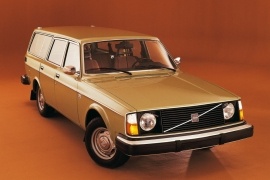VOLVO 245 Models/Series Timeline, Specifications & Photos
First production year: 1975
Engines: Gasoline, Diesel
Body style: Wagon (station wagon, estate, combi, touring)
Volvo introduced the 200 series in 1974 as a sedan with two or four doors, and the station wagon followed in 1975.
The Swedish carmaker had a different way of naming its cars. For the 245, for instance, the 2 was for the series, the 4 was for the number of cylinders, and the 5 was for the doors numbers. Thus, the 245 meant in Volvo language that it was a station wagon with a four-pot unit under the hood.
With a design language of a brick and the finesse of a Sherman tank, the Volvo 245 offered the image of a safe vehicle. Its bumpers were 5 mph (8 kph) rule compliant long before other carmakers even considered studying the problem. In the beginning, the 200 series featured round headlights and a black grille between them. The greenhouse looked like a shed with windows was mounted on top of a wagon with flat panels.
Inside, the 245 provided room for five and a folding bench in the rear. Despite the transmission tunnel, the car provided three real seats in the back thanks to the high roof. Its trunk was considerably large and could have been used as a tent in a camping area or on the side of the road.
The 245 was launched without an AC unit, but that was added later on, especially for the U.S. market. In Sweden, nobody needed it. The 245 was equipped with a 3-speed automatic transmission for more comfort, while the 4-speed manual was paired as standard. The basic engine was the inline-four unit that evolved from a 2.0-liter to a 2.3-liter for the latter models.
